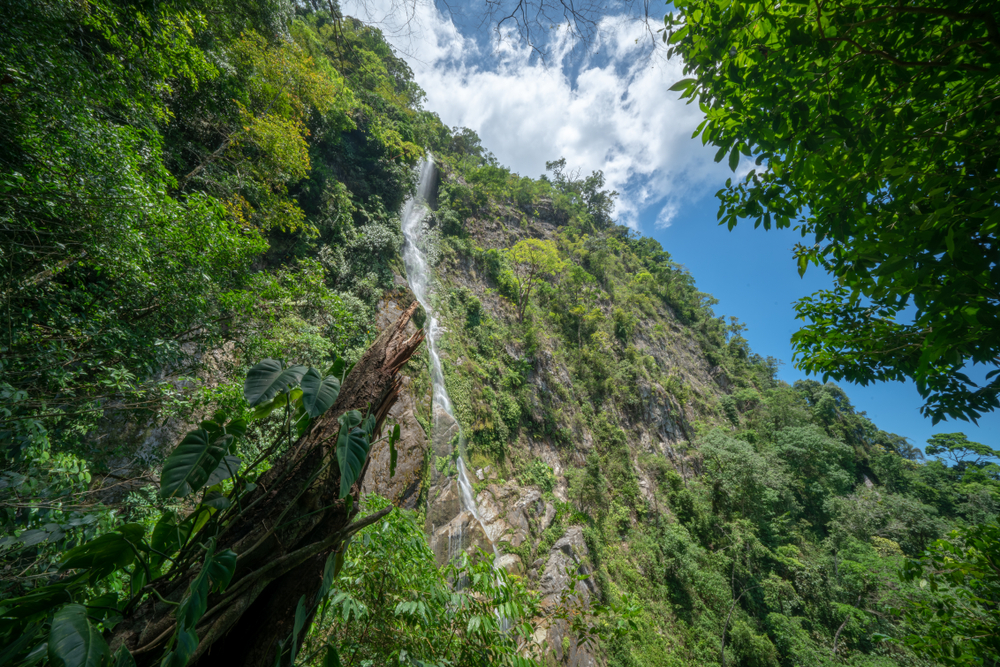Sierra de Agalta Overview
Sierra de Agalta National Park, known locally as Parque Nacional Sierra de Agalta, is a biodiverse protected area in eastern Honduras. Encompassing approximately 257 square miles (666 square kilometers), the park is located in the Olancho Department, a region characterized by rugged mountains, deep valleys, and dense cloud forests.
The park is part of the larger Cordillera de Agalta, a mountain range that rises dramatically from the surrounding lowlands. Its highest peaks, such as Cerro La Picucha, reach over 7,500 feet (2,300 meters), offering breathtaking vistas and cool, misty conditions that support a lush and diverse ecosystem. Numerous rivers and streams, including the Río Guayape and Río Tinto, carve through the landscape, feeding cascading waterfalls and creating an environment teeming with life.
The park’s terrain varies from steep, rocky cliffs to rolling hills blanketed in thick forests, including tropical rainforests and cloud forests rich in epiphytes, mosses, and towering trees. The vegetation is incredibly diverse, with towering mahogany, oak, and ceiba trees forming dense canopies that shelter a wealth of plant life.
Bromeliads and orchids cling to branches, adding bursts of color to the green expanse, while ferns and thick undergrowth create a thriving understory. This rich flora provides a sanctuary for an impressive array of wildlife, many of which are endemic or endangered.
Sierra de Agalta National Park is home to an extraordinary variety of wildlife, making it a prime destination for nature enthusiasts and researchers. Mammals such as jaguars, pumas, ocelots, and Baird’s tapirs roam the forests, while smaller creatures like agoutis, armadillos, and howler monkeys add to the park’s vibrant biodiversity.
Birdwatchers will find a paradise here, as the park hosts hundreds of bird species, including the resplendent quetzal, keel-billed toucan, emerald toucanet, and the rare harpy eagle. The calls of parrots and trogons echo through the forest, while hummingbirds dart between the flowers, feeding on nectar. Reptiles and amphibians, such as the Honduran emerald lizard and various species of tree frogs, thrive in the park’s humid environment.
Visitors to Sierra de Agalta National Park are drawn by its remote beauty and sense of untouched wilderness. Popular features include the stunning waterfalls hidden within the dense forests, such as Cascada El Carbon and the scenic viewpoints atop the mountain ridges.
The vast network of rivers and caves offers additional opportunities for exploration. Hiking is one of the best ways to experience the park, with trails winding through thick vegetation, past waterfalls, and up to panoramic viewpoints. Birdwatching is another favorite activity, attracting enthusiasts eager to spot some of the region’s rarest species.
For those seeking adventure, camping in the park’s remote areas allows for an immersive experience in one of Honduras’ most pristine natural environments.
Conservation efforts within Sierra de Agalta National Park have been met with both successes and challenges. Deforestation, illegal logging, and agricultural expansion have threatened parts of the park, leading to habitat loss for many species.
However, local conservation organizations and government initiatives have worked to implement stricter protections, reforestation projects, and sustainable tourism practices. Community engagement programs have also played a role in educating local populations about the importance of preserving the park’s ecosystems.
Despite ongoing threats, Sierra de Agalta remains a vital sanctuary for biodiversity, and conservation efforts continue to ensure that future generations can experience its natural wonders.
Park Map
Sierra de Agalta National Park Highlights
Share your clicks with us
Related National Parks More Honduras

Punta Izopa National Park

Port Royal National Park

Nombre de Dios National Park

Montaña de Botaderos Carlos Escaleras Mejía National Park

Montaña de Comayagua National Park

Omoa National Park

Pico Pijol National Park

Pico Bonito National Park

La Tigra National Park










































































